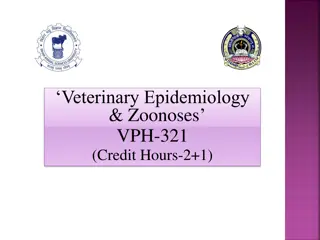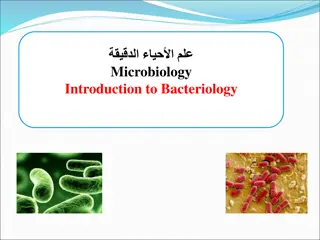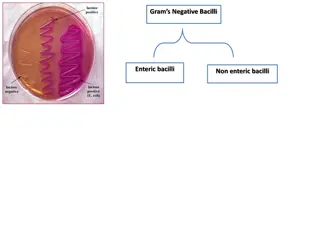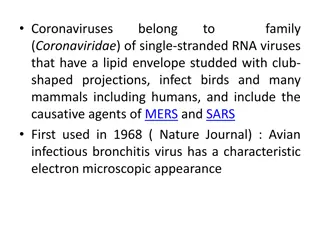Understanding Vibrio and Related Organisms in Medical Bacteriology
Vibrio, Aeromonas, and Plesiomonas are gram-negative bacilli commonly found in water sources, causing gastrointestinal diseases. They exhibit similarities to Enterobacteriaceae but with distinct characteristics such as polar flagella and being oxidase-positive. Vibrios like V. cholerae are crucial h
1 views • 25 slides
Bacterial Biochemical Identification Tests in Microbiology
Understand the significance of biochemical tests like the Triple Sugar Iron Agar Test (TSI) and the IMViC Test for identifying enteric bacteria. Learn about indole production, methyl red test, and other methods used in bacteriology.
5 views • 17 slides
Understanding Enteric Fever (Typhoid Fever): Causes, Contagiousness, and Prognosis
Enteric fever, commonly known as typhoid fever, is an acute illness caused by Salmonella typhi bacteria transmitted through contaminated food or water. This fever is highly contagious, with individuals becoming carriers even after recovering. Close contact, contaminated water, and poor sanitation co
0 views • 18 slides
Understanding Gelatin Capsules in Pharmaceutical Formulations
Gelatin capsules are versatile dosage forms used to encapsulate various types of medicinal agents. This article explores the types of gelatin capsules, including hard, soft, and enteric-coated capsules, their composition, uses, and storage requirements. Gain insights into the differences between the
1 views • 16 slides
Klebsiella Species: Characteristics and Pathogenicity
Klebsiella species, such as K. pneumoniae and K. oxytoca, are gram-negative bacilli commonly found in the microbiota of the intestines, nasopharynx, and feces. They exhibit distinct characteristics like pink mucoid colonies on MacConkey's agar and are known to cause both community-acquired and hospi
0 views • 24 slides
Understanding Biochemical Tests for Bacterial Identification
Explore the importance of biochemical tests like Triple Sugar Iron Agar and IMViC in identifying enteric bacteria. Learn about indole production and the Methyl Red test, essential in distinguishing bacterial species based on their metabolic activities. Discover how these tests aid in diagnosing food
2 views • 17 slides
Understanding Film Forming Agents for Tablet Coating in Pharmaceuticals
Film forming agents play a crucial role in tablet coating, providing mechanical strength and desired film characteristics. Non-enteric film formers like HPMC, MHEC, EC, HPC, Povidone, SCMC, and PG Acrylate Polymers are commonly used for uniform film formation. Each agent has unique properties and pr
1 views • 10 slides
Understanding Triple Sugar Iron Agar (TSI Agar) Test
Triple Sugar Iron Agar (TSI Agar) is a differential media used for identifying gram-negative enteric bacilli based on carbohydrate fermentation and hydrogen sulfide production. It helps detect carbohydrate fermentation, gas production, acidification, and H2S formation, providing valuable information
1 views • 28 slides
Understanding the Triple Sugar Iron Test in Biochemical Analysis
The Triple Sugar Iron Test (TSI) is a crucial biochemical test used to differentiate gram-negative enteric bacilli based on their carbohydrate fermentation and hydrogen sulfide production. By examining color changes, gas production, and precipitate formation, microbiologists can interpret TSI result
2 views • 31 slides
Understanding Viral Gastroenteritis: Causes, Symptoms, and Transmission
Viral gastroenteritis, commonly known as viral diarrhea, is a prevalent infection affecting mainly infants and young children. The disease is self-limiting, with symptoms like diarrhea, vomiting, and abdominal pain. Key viral etiologies include Rota viruses, Astroviruses, Norovirus, and Enteric aden
0 views • 19 slides
Understanding Tuberculosis: A Comprehensive Overview of the Disease
Tuberculosis, a chronic disease affecting both humans and animals, is caused by pathogenic Mycobacterium spp. This article covers the etiology, synonyms, history, and geographic distribution of tuberculosis, along with key terms like anthropozoonosis and zooanthroponosis. Learn about the tubercle ba
0 views • 24 slides
Understanding Small Intestine Motor Functions and Control in GIT Physiology
The lecture discusses the motor functions of the small intestine, including segmentation and peristaltic contractions. It covers factors affecting intestinal peristalsis and the role of gastro-enteric reflex. The small intestine's structure, functions in digestion and absorption, and common disorder
0 views • 17 slides
Cutting-Edge Research Equipment and Studies at The Aga Khan University, Pakistan
The research facilities at The Aga Khan University in Pakistan boast state-of-the-art equipment for groundbreaking studies in areas like enteric fever prevention, rotavirus vaccine impact assessment, and dental stem cells. Researchers utilize specialized tools such as refrigerated centrifuges, biosa
0 views • 29 slides
Understanding Bacterial Form and Function: Structures, Shapes, and Arrangements
Explore the diverse structures common to bacterial cells, including membranes, ribosomes, and chromosomes. Learn about the shapes and arrangements of bacteria, such as cocci, bacilli, and spirilla. Discover external appendages that provide motility and aid in attachment and mating.
0 views • 85 slides
Introduction to Bacterial Cells Morphology in Microbiology
Bacteria are ubiquitous microorganisms with diverse shapes and arrangements. They exist as bacilli (rod-shaped), cocci (spherical), and spirilla (spiral-shaped). Actinomycetes are filamentous bacteria resembling molds. Understanding bacterial cell morphology is crucial in microbiology studies.
0 views • 16 slides
Understanding Triple Sugar Iron Agar (TSI Agar) Test in Microbiology
Gain insights into the Triple Sugar Iron Agar (TSI Agar) test used for differentiating gram-negative enteric bacilli based on carbohydrate fermentation and hydrogen sulfide production. Learn about detecting carbohydrate fermentation, interpreting results, and performing the test accurately with deta
0 views • 28 slides
Overview of Gram-Negative Enteric Bacilli
Gram-negative bacilli are a diverse group of bacteria, including enteric and non-enteric bacilli. Common characteristics include being aerobic or facultative anaerobes, fermenting glucose, and being part of the normal flora of the human and animal gastrointestinal tract. Escherichia coli (E. coli) i
0 views • 27 slides
Overview of Salmonella Infections and Pathogenicity
Salmonella bacteria, often transmitted through contaminated food or drink, can cause various infections in humans and animals. They are identified by their morphology, and classified into different species and subtypes. The pathogenesis of Salmonella infections varies, with some species infective pr
0 views • 18 slides
Salmonellosis: Understanding the Disease and Its Implications
Salmonellosis is a bacterial infection caused by various serotypes of the Salmonella bacteria. The disease is transmitted through contaminated food, direct contact with infected animals, or the fecal-oral route in endemic areas. Typhoidal Salmonella serovars can lead to serious conditions like enter
0 views • 23 slides
Integrated Pest Management and the Use of Probiotics in Broiler Production
Tips for broiler producers include implementing integrated pest management strategies and utilizing probiotics in poultry feeds to enhance gut health, control diseases, and improve productivity. With concerns over antibacterial resistance, alternatives to antibiotics such as probiotics and prebiotic
0 views • 13 slides
New Requirements for PRRS & SECD Testing in Swine
The new rule mandates testing for Porcine Reproductive Respiratory Syndrome (PRRS) and Swine Enteric Corona Virus Disease (SECD) in swine moving into or within Wisconsin, with specific guidelines for testing, movement to exhibitions, and commercial farm scenarios. The rules also outline procedures f
0 views • 11 slides
Understanding Coronavirus: Prevention and Safety Measures
Coronaviruses are single-stranded RNA viruses that infect birds, mammals, and humans. They can cause respiratory and enteric diseases, hepatitis, and neurologic issues. Initially of veterinary interest, coronavirus spread has escalated into human-to-human transmission. WHO recommends handwashing, co
0 views • 13 slides
Overview of Enterobacteriaceae Classification with Focus on Typhoidal Salmonella
Enterobacteriaceae is a bacterial family that includes Salmonella species. Typhoidal Salmonella, such as S. Typhi and S. Paratyphi, cause enteric fevers in human hosts. This user-friendly classification system categorizes Salmonella strains based on their clinical impact and host specificity.
0 views • 42 slides






















